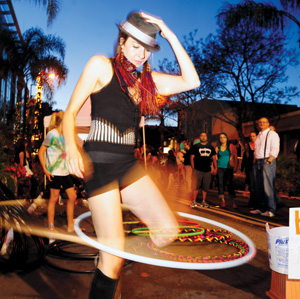

FOR Silicon Alleys, the final stages of 2010 call for some year-ending reflection. Alleys are side passages usually subordinated by society to the “in-between.” The alley denizen occupies the interstices. He operates between the cracks—geographically, creatively and even psychically.
He’s a sucker for anything that fogs the opposites of urban and suburban, native and exotic, luxury and the gutter, object and subject, academe and the street. As his friends throughout the rest of these pages recall highs and lows from the last 52 weeks, he will fondly do the same.
Since “Eden” usually means paradise, at least in crossword puzzles, the author felt heavenly during an unprecedented synchronicity of Edens. One day, he found himself reading Charles Sullivan’s Like Modern Edens: Winegrowing in Santa Clara Valley and Santa Cruz Mountains 1798–1981. Two days later, he stumbled across Timothy Leary’s legendary monolog on how the Garden of Eden constituted the first drug bust.
One more day later, at the mayor of San Jose’s State of the City address, a rabbi provided the words: “Our city is our Eden. … What we do today in San Jose began with Eden, as a charge to protect and to create, to see with open eyes and to dream.”
So the columnist wrote about how God sent the phylloxera epidemic to destroy all the vineyards in Santa Clara Valley and turn San Jose into the Prune Capital of the World. The Grand Snarkitect of the Universe just doesn’t want San Jose to become famous for anything interesting.
In other columns, the anti-man-about-town journeyed across oceans. While in Thailand, he penned a yarn about journalist Bob Tilley, whose pub, the Chiang Mai Writers Club and Wine Bar, functions as the unofficial wayward correspondent’s club. The author began the piece and then filed the column from the China Airlines Business-Class Lounge in Taiwan.
Europe also provided inspiration. One column surfaced from the mystical fringes of the San Jose–Dublin sister-city relationship, while subsequent communiqués materialized in the Altstadt neighborhood of Düsseldorf and the Ramones Museum in Berlin. A trip back across the pond found the author in Edinburgh, where he immersed himself in haggis and Harry Potter.
On a trip to Edmonton, the same character found his northern muse at a Van Morrison gig and wrote a column from Room 410 at the Union Bank Inn. On that same sojourn, he witnessed 40 utility boxes painted with vivid murals, knowing such a groovy project would never occur in San Jose. He then returned home with a common ailment known as “Post-travel I Hate San Jose Syndrome” and is still undergoing a mindfulness-based stress-reduction program.
Columns on the local front included musings on Josh Marcotte’s Lost San Jose photo exhibits, the annual Conspiracy Conference in Santa Clara, a Western esoteric traditions conference at the Rosicrucian Museum and forgotten record stores in San Jose—essentially, anything hidden or in-between. There is a crack in everything. That’s how the light gets in, as Leonard Cohen said.
In 2010, San Jose’s art scene came alive, and festivals combined highbrow with lowbrow in ways one would only see in Silicon Valley. The 01SJ Biennial evolved yet again, constantly redefining the interstices of digital culture, new media ecologies, art practice, computer music, performance, garage tinkering, wired hipsterism, dance, open-source theory and new environmentalism.
A month later, the Dalai Lama showed up. A propos of the situation, a process-oriented humor column explored the Buddhist concept of dependent origination, connecting several interdimensional cause-and-effect relationships within the author’s own personal spheres of awareness. One irritatingly literal reader didn’t get it, so she wrote in and complained, but such is life. (Does anybody remember laughter?)
On the darker side of things, the Urban Blight Junkie relapsed again, this time at Hacienda Gardens, one of the most brutish examples of landlord neglect in San Jose history. One week later, though, he found the right path to recovery, inspired by Osho’s concept of Zorba the Buddha—perhaps an ideal example of transcending binary opposites through his art in order to improve his conditions. Stay tuned for more snarky reports from the in between.



